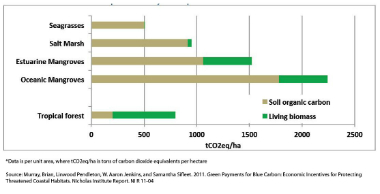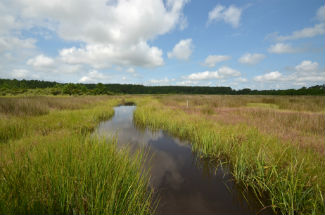 Michael Burchell, in red, smells a plug of soil from North River Farms and passes it around to people attending the Blue Carbon Workshop. The roots in the soil are an important location for carbon dioxide or, in the case of a salt marsh, “blue carbon.” Photo: Tess Malijenovsky |
SMYRNA — Out in the middle of a salt marsh in rural, coastal North Carolina a small group of scientists, land managers, engineers and conservationists gather around, passing a plug of wet, black soil. They rub it between their fingertips then bring it up to their faces for a closer look and a long whiff — that rotten-egg smell of sulfur, rich with hope and opportunity.
The mats of roots in the soil are a clue to something invisible, something driving global research and discussion. They call it “blue carbon,” after the carbon dioxide that’s taken up and stored by ecosystems near the ocean — salt marshes, tidal wetlands, mangroves and sea grasses. However, it means much more than that for us all.
Supporter Spotlight
Aside from improving water quality, providing habitat to fish and wildlife and protecting us from floods and storm surges, the salt marshes and tidal wetlands of eastern North Carolina provide a newly recognized and highly valuable “service” — they help fight climate change, big time. And that’s marketable.
What is actually being measured when anyone speaks of blue carbon is the net amount of greenhouse gasses being released and absorbed by a coastal marine ecosystem, such as a salt marsh. Greenhouse gasses like carbon dioxide, methane and nitrous oxide are the ones warming the planet. If a salt marsh acts as a sink, draining the heat-trapping gases out of the atmosphere, then it could be sold on the global carbon market in the form of a carbon offset credit.
“It’s an additional ecosystem service, and we’re becoming increasingly attuned to the need to mitigate climate change. So by recognizing this, it adds a little bit more of the imperative to restore (coastal) landscapes. Hopefully it will bring more funding to agencies who do ecosystem restoration,” said Steve Crooks, a global expert and consultant on blue carbon.
Crooks was one of the people examining the marsh soil. He came to Beaufort two weeks ago for the two-day workshop on blue carbon put on by Restore America’s Estuaries, a national nonprofit, and one of its regional partners, the N.C. Coastal Federation. Joining him was Restore America’s Estuaries’ senior director of strategic planning and programs, Steve Emmett-Mattox.
 This graph shows the amount of carbon dioxide in tons per hectare sequestered and stored by different ecosystems; the brown represents the carbon in soil and the green, in plants. The order of ecosystems are as follows: sea grass, salt marsh, estuarine mangroves, oceanic mangroves and tropical forests. The top four coastal marine ecosystems are, in most cases, more effective carbon sinks than tropical forests. Source: Murray, Brian, Linwood Pendleton, W. Aaron Jenkins, and Samantha Sifleet. 2011. Green Payments for Blue Carbon: Economic Incentives for Protecting Threatened Coastal Habitats. Nicholas Institute Report. |
“If you work in the restoration sector, you know that there’s a lot of unmet need to restore these habitats and we need more resources,” Emmett-Mattox said.
Supporter Spotlight
He came to the workshop to help land managers in the Southeast begin to understand this emerging topic and its potential for bringing financial resources to their conservation work. After all, the term blue carbon has only been around about five years and its science is still rapidly evolving.
For a plant, carbon dioxide is like pie. They “sequester” the pie – take it in – and store it throughout their bodies, the “biomass,” and into the soil via their roots. What makes these “blue” ecosystems near the ocean the pie-eating-contest champions of the planet is their wet, salty environment that keeps methane emissions extremely low and slows the breakdown of carbon. Also, they have a deep layer of organic-rich soil that stores hundreds of tons of carbon dioxide, much deeper than what is below a terrestrial forest.
By comparison, coastal marine ecosystems store more greenhouse gasses per acre than a tropical rainforest. And though they only make up six percent of land area covered by tropical forests, when they’re destroyed they contribute one-fifth of all emissions attributed to deforestation worldwide. It may take hundreds of years for carbon to build up in the soil, but it only takes a matter of days to be released back into the atmosphere when tidal wetlands are ditched and drained.
On the second day of the workshop, the group traveled to one of the federation’s wetland restoration projects called North River Farms. Looking around, it was hard to believe that the marsh everyone was standing in had been a farm for 30 years. It’s taken roughly seven years to restore the farmland into tidal wetlands, and now the federation wants to know whether it’s storing more greenhouse gasses than it’s emitting. Over the last three years, N.C. State University has been doing that groundbreaking research with funding from the U.S. Geological Survey.
“There hadn’t been a lot of studies in wetlands that are as salty as this brackish marsh, so there was kind of a hole left in the science on this,” said Michael Burchell, the lead project researcher and an associate professor at N.C. State who has been monitoring, designing and restoring the farm since 2003.
Freshwater wetlands naturally generate a significant amount of methane, which is over 20 times more potent than carbon dioxide. Would a brackish tidal marsh with saltier conditions also generate so much methane that it offsets the carbon being taken in through the plants?
 This restored marsh was once a farm growing corn and soy. Now it is a carbon sink. North River Farms is one of the N.C. Coastal Federation’s wetland restoration projects. Photo: Tess Malijenovsky |
The short answer is no.
“What we learned was that there is very little methane that is being produced in these brackish marsh systems,” said Burchell, a result of the microorganisms in the soil using sulfur instead of methane, which gives off that rotten-egg smell. He and his doctorate student, Yo-Jin Shiau, also found that while the marsh is giving off some carbon dioxide, “[it] is acting as a true sink for carbon meaning there’s more carbon coming into the system and being trapped than leaving.”
Therefore, restored coastal marshes have a role to play in the global effort to address climate change.
“Why I’m excited about the North River Farms work,” Emmett-Mattox said, “is I think all of that really adds important knowledge that coastal managers can use.
“I think where we are is that we need a better understanding in specific places and specific estuaries as to what the carbon benefits of conserving and restoring those habitats really are because there’s still relatively few places where this is being measured and considered,” he said.
Over 40 people showed up for the workshop from across the Southeast, which was funded by the National Oceanic and Atmospheric Administration and U.S. Fish and Wildlife Service. At the workshop, attendees learned about the tools and standards that exist to verify credits and how to assess the blue carbon potential of a project. The lesson chief among them though was that blue carbon creates an economic incentive to conserve and restore our coastal ecosystems, or as some workshop attendees said “to do the right thing.”
So, go on, next time you look out over the salt marsh, see if it doesn’t smell a little sweeter.







